Jean-Philippe Ovarlez
SAFE: a SAR Feature Extractor based on self-supervised learning and masked Siamese ViTs
Jun 30, 2024Abstract:Due to its all-weather and day-and-night capabilities, Synthetic Aperture Radar imagery is essential for various applications such as disaster management, earth monitoring, change detection and target recognition. However, the scarcity of labeled SAR data limits the performance of most deep learning algorithms. To address this issue, we propose a novel self-supervised learning framework based on masked Siamese Vision Transformers to create a General SAR Feature Extractor coined SAFE. Our method leverages contrastive learning principles to train a model on unlabeled SAR data, extracting robust and generalizable features. SAFE is applicable across multiple SAR acquisition modes and resolutions. We introduce tailored data augmentation techniques specific to SAR imagery, such as sub-aperture decomposition and despeckling. Comprehensive evaluations on various downstream tasks, including few-shot classification, segmentation, visualization, and pattern detection, demonstrate the effectiveness and versatility of the proposed approach. Our network competes with or surpasses other state-of-the-art methods in few-shot classification and segmentation tasks, even without being trained on the sensors used for the evaluation.
Theory and Implementation of Complex-Valued Neural Networks
Feb 16, 2023



Abstract:This work explains in detail the theory behind Complex-Valued Neural Network (CVNN), including Wirtinger calculus, complex backpropagation, and basic modules such as complex layers, complex activation functions, or complex weight initialization. We also show the impact of not adapting the weight initialization correctly to the complex domain. This work presents a strong focus on the implementation of such modules on Python using cvnn toolbox. We also perform simulations on real-valued data, casting to the complex domain by means of the Hilbert Transform, and verifying the potential interest of CVNN even for non-complex data.
Deep Learning-Based Anomaly Detection in Synthetic Aperture Radar Imaging
Oct 28, 2022Abstract:In this paper, we proposed to investigate unsupervised anomaly detection in Synthetic Aperture Radar (SAR) images. Our approach considers anomalies as abnormal patterns that deviate from their surroundings but without any prior knowledge of their characteristics. In the literature, most model-based algorithms face three main issues. First, the speckle noise corrupts the image and potentially leads to numerous false detections. Second, statistical approaches may exhibit deficiencies in modeling spatial correlation in SAR images. Finally, neural networks based on supervised learning approaches are not recommended due to the lack of annotated SAR data, notably for the class of abnormal patterns. Our proposed method aims to address these issues through a self-supervised algorithm. The speckle is first removed through the deep learning SAR2SAR algorithm. Then, an adversarial autoencoder is trained to reconstruct an anomaly-free SAR image. Finally, a change detection processing step is applied between the input and the output to detect anomalies. Experiments are performed to show the advantages of our method compared to the conventional Reed-Xiaoli algorithm, highlighting the importance of an efficient despeckling pre-processing step.
Impact of PolSAR pre-processing and balancing methods on complex-valued neural networks segmentation tasks
Oct 28, 2022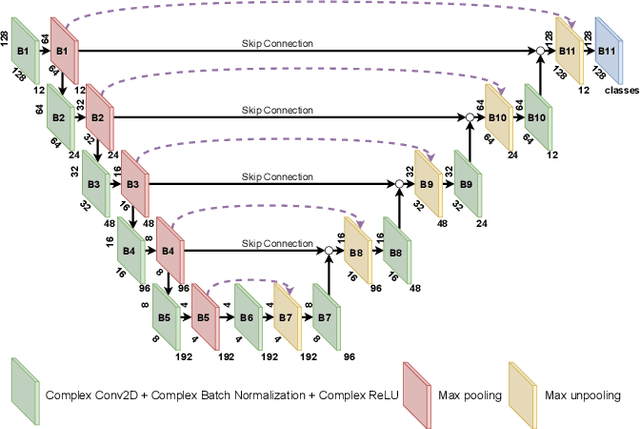
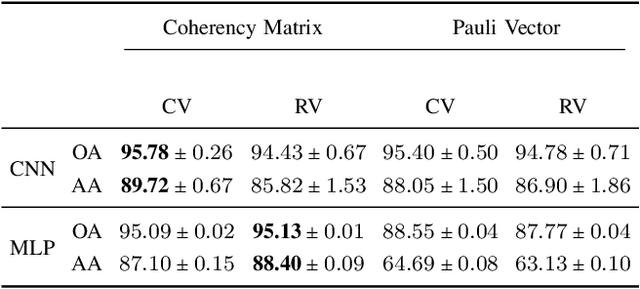
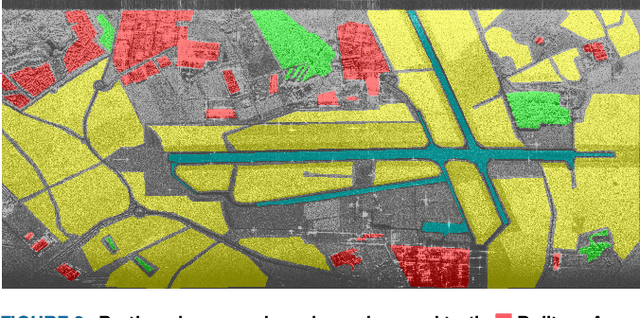
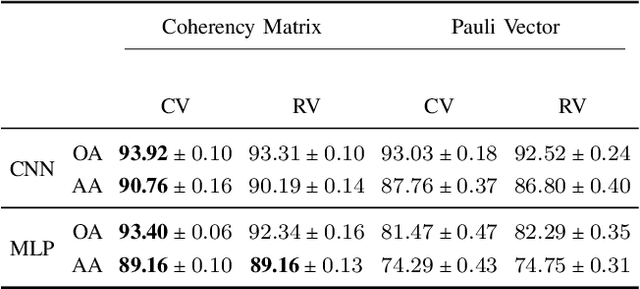
Abstract:In this paper, we investigated the semantic segmentation of Polarimetric Synthetic Aperture Radar (PolSAR) using Complex-Valued Neural Network (CVNN). Although the coherency matrix is more widely used as the input of CVNN, the Pauli vector has recently been shown to be a valid alternative. We exhaustively compare both methods for six model architectures, three complex-valued, and their respective real-equivalent models. We are comparing, therefore, not only the input representation impact but also the complex- against the real-valued models. We then argue that the dataset splitting produces a high correlation between training and validation sets, saturating the task and thus achieving very high performance. We, therefore, use a different data pre-processing technique designed to reduce this effect and reproduce the results with the same configurations as before (input representation and model architectures). After seeing that the performance per class is highly different according to class occurrences, we propose two methods for reducing this gap and performing the results for all input representations, models, and dataset pre-processing.
Riemannian optimization for non-centered mixture of scaled Gaussian distributions
Sep 07, 2022



Abstract:This paper studies the statistical model of the non-centered mixture of scaled Gaussian distributions (NC-MSG). Using the Fisher-Rao information geometry associated to this distribution, we derive a Riemannian gradient descent algorithm. This algorithm is leveraged for two minimization problems. The first one is the minimization of a regularized negative log- likelihood (NLL). The latter makes the trade-off between a white Gaussian distribution and the NC-MSG. Conditions on the regularization are given so that the existence of a minimum to this problem is guaranteed without assumptions on the samples. Then, the Kullback-Leibler (KL) divergence between two NC-MSG is derived. This divergence enables us to define a minimization problem to compute centers of mass of several NC-MSGs. The proposed Riemannian gradient descent algorithm is leveraged to solve this second minimization problem. Numerical experiments show the good performance and the speed of the Riemannian gradient descent on the two problems. Finally, a Nearest centroid classifier is implemented leveraging the KL divergence and its associated center of mass. Applied on the large scale dataset Breizhcrops, this classifier shows good accuracies as well as robustness to rigid transformations of the test set.
Robust Geometric Metric Learning
Feb 23, 2022

Abstract:This paper proposes new algorithms for the metric learning problem. We start by noticing that several classical metric learning formulations from the literature can be viewed as modified covariance matrix estimation problems. Leveraging this point of view, a general approach, called Robust Geometric Metric Learning (RGML), is then studied. This method aims at simultaneously estimating the covariance matrix of each class while shrinking them towards their (unknown) barycenter. We focus on two specific costs functions: one associated with the Gaussian likelihood (RGML Gaussian), and one with Tyler's M -estimator (RGML Tyler). In both, the barycenter is defined with the Riemannian distance, which enjoys nice properties of geodesic convexity and affine invariance. The optimization is performed using the Riemannian geometry of symmetric positive definite matrices and its submanifold of unit determinant. Finally, the performance of RGML is asserted on real datasets. Strong performance is exhibited while being robust to mislabeled data.
Complex-Valued vs. Real-Valued Neural Networks for Classification Perspectives: An Example on Non-Circular Data
Sep 17, 2020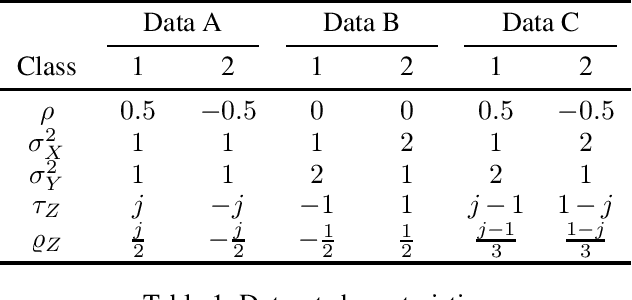
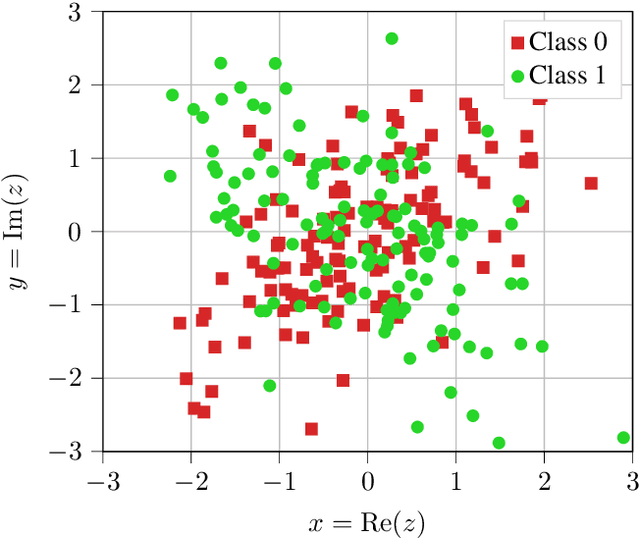
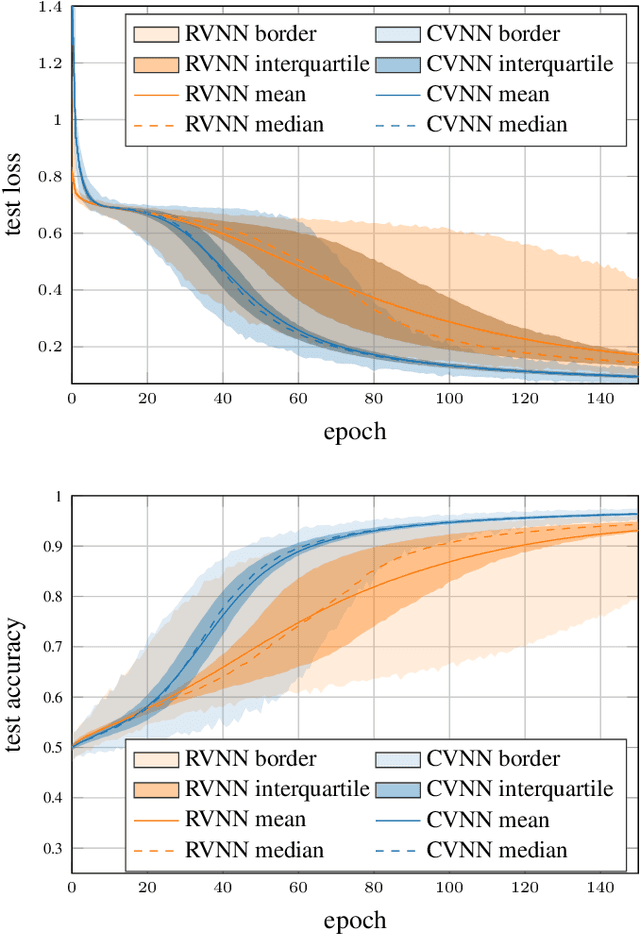

Abstract:The contributions of this paper are twofold. First, we show the potential interest of Complex-Valued Neural Network (CVNN) on classification tasks for complex-valued datasets. To highlight this assertion, we investigate an example of complex-valued data in which the real and imaginary parts are statistically dependent through the property of non-circularity. In this context, the performance of fully connected feed-forward CVNNs is compared against a real-valued equivalent model. The results show that CVNN performs better for a wide variety of architectures and data structures. CVNN accuracy presents a statistically higher mean and median and lower variance than Real-Valued Neural Network (RVNN). Furthermore, if no regularization technique is used, CVNN exhibits lower overfitting. The second contribution is the release of a Python library (Barrachina 2019) using Tensorflow as back-end that enables the implementation and training of CVNNs in the hopes of motivating further research on this area.
Automatic Target Detection for Sparse Hyperspectral Images
Apr 14, 2019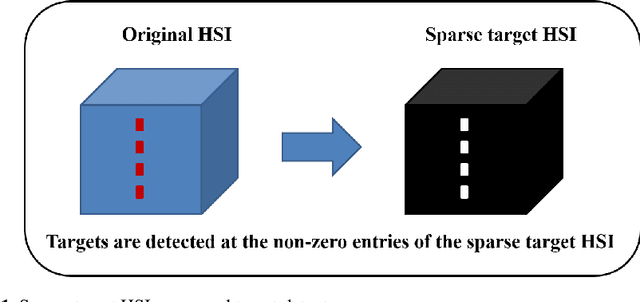

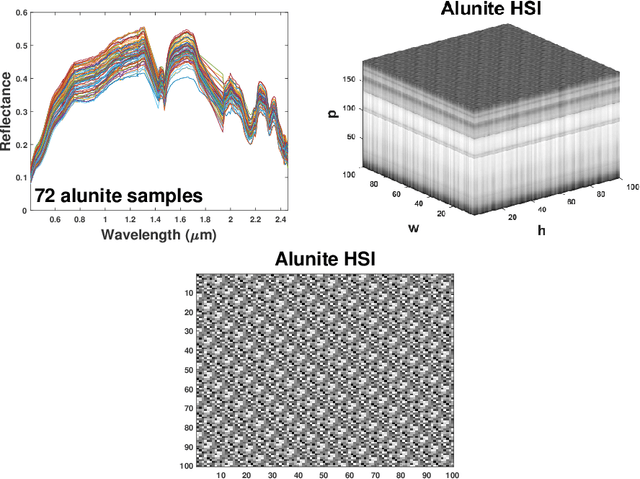

Abstract:This chapter introduces a novel target detector for hyperspectral imagery. The detector is independent on the unknown covariance matrix, behaves well in large dimensions, distributional free, invariant to atmospheric effects, and does not require a background dictionary to be constructed. Based on a modification of the Robust Principal Component Analysis (RPCA), a given hyperspectral image (HSI) is regarded as being made up of the sum of low-rank background HSI and a sparse target HSI that contains the targets based on a pre-learned target dictionary specified by the user. The sparse component (that is, the sparse target HSI) is directly used for the detection, that is, the targets are simply detected at the non-zero entries of the sparse target HSI. Hence, a novel target detector is developed and which is simply a sparse HSI generated automatically from the original HSI, but containing only the targets with the background is suppressed. The detector is evaluated on real experiments, and the results of which demonstrate its effectiveness for hyperspectral target detection especially when the targets have overlapping spectral features with the background.
 Add to Chrome
Add to Chrome Add to Firefox
Add to Firefox Add to Edge
Add to Edge